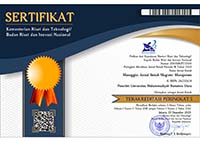Development Plans for Employee Engagement in Banking Institution during the Covid-19 Pandemic
Abstract
This study aims to identify the factor of employee engagement and analyze the current condition of employee engagement. The author gains in scope and depth of understanding and collaboration by mixing both qualitative and quantitative methods. Primary data is gathered from the questionnaire and interview with some employees, while secondary data is obtained from the company's annual report, a private document, and related journals. In addition to validity and reliability testing, the data will also be analyzed using statistical techniques. Some approaches are also applicable for assessing employee engagement results, such as Grand Mean, Top Box, and Engagement Scores. The results of the interview support data analysis. The triangulation technique uses to combine both results of the questionnaire and interview. The triangulation helps to confirm the findings, enhance understanding, and increase the validity. Based on the analysis, the author found several factors such as culture, opportunity, quality of life, people, and rewards. The study's result can be used to recommend the company to improve engagement during the Covid-19 pandemic.
Keywords
Full Text:
PDF (Bahasa Indonesia)References
Bedarkar, M., & Pandita, D. (2014). A study on the drivers of employee engagement impacting employee performance. Social and Behavioral Sciences, 106 115.
Bilal, H., Waseem, M., & Ali, S. (2020). Pragmatic impact of loyalty on deviant workplace behavior among banking sector employees. Journal of Accounting and Finance in Emerging Economies, 407-414.
Choudhury, S., & Mohanty, M. K. (2019). Drivers of employee engagement a chronological literature review excluding India. Journal of Strategic Human Resource Management, 3246.
Gallup. (2020). Diambil kembali dari q12.gallup.com
Garg, P. (2014). Impact of employee engagement in its sector. International Journal of Management Research and Review, 62-72.
Gupta, A. D. (2020). Strategic Human Resource Management. New York: Routledge.
Hidayat, R., & Budiatma, J. (2018). Education and job training on employee performance. International Journal of Social Sciences and Humanities, 171-181.
Kazimoto, P. (2016). Employee engagement and organizational performance of retail enterprises. American Journal of Industrial and Business Management, 516525.
Kerdpitak, C., & Jermsittiparsert, K. (2020). Human resource management practices on competitive advantage: the mediating role of employee engagement in Thailand. Sys Rev Pharm, 443-452.
Koodamara, N. (2017). Procedural justice, distributive justice, and interactional justice as the antecedents of employee engagement. International Journal of Scientific Research, 330.
Pieters, W. R. (2018). Assessing organizational justice as a predictor of job satisfaction and employee engagement in Windhoek. SA Journal of Human Resource Management, 1683-1694.
Queiros, A., Faria, D., & Almeida, F. (2017). Strengths and Limitations of Qualitative and Quantitative Research Methods. European Journal of Education Studies, 369-387.
Raja, S., & Madhavi, C. (2019). Influence of organizational climate on employee performance in the manufacturing industry. Suraj Punj Journal for Multidisciplinary Research, 146157.
Saxena, V., & Srivastava, R. K. (2015). Impact of employee engagement on employee performance. International Journal of Management Research and Business Strategy, 139-174.
Schalkwyk, S. V., Toit, D. H., Bothma, A. A., & Rothmann, S. (2010). Job insecurity, leadership empowerment behavior, employee engagement, and intention to leave in a petrochemical laboratory. SA Journal of Human Resource Management, 1-7.
Sendawula, K., Kimuli, S. K., Bananuka, J., & Muganga, G. N. (2018). Training, employee engagement, and employee performance: evidence from Uganda's health sector. Cogent Business & Management, 1-12.
Stangrecka, H. B. (2020). The relationship between inter-organizational trust and employee engagement and performance. Academy of Management, 8-25.
Tsukudu, T. T. (2020). Employee engagement and staff turnover and its implication on the organizational performance: the case of AON Botswana. International Journal of Economic Behavior and Organization, 1-11.
Wisdom, J., & Creswell, J. W. (2013). Mixed Methods: Integrating Quantitative and Qualitative Data Collection and Analysis While Studying Patient-Centered Medical Home Models. AHRQ, 1-6.
DOI: https://doi.org/10.30596/maneggio.v4i2.6905
Refbacks
- There are currently no refbacks.






